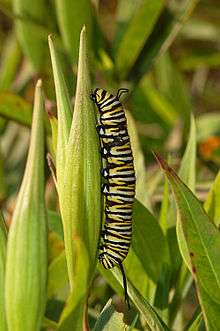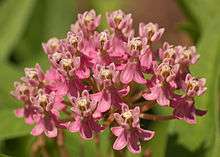Asclepias incarnata
Asclepias incarnata, the swamp milkweed, rose milkweed, rose milkflower, swamp silkweed, or white Indian hemp, is a herbaceous perennial plant species native to North America.[2] It grows in damp to wet soils and also is cultivated as a garden plant for its flowers, which attract butterflies and other pollinators with nectar. Like most other milkweeds, it has latex containing toxic chemicals,[3] a characteristic that repels insects and other herbivorous animals.
| Asclepias incarnata | |
|---|---|
 | |
| Scientific classification | |
| Kingdom: | Plantae |
| Clade: | Tracheophytes |
| Clade: | Angiosperms |
| Clade: | Eudicots |
| Clade: | Asterids |
| Order: | Gentianales |
| Family: | Apocynaceae |
| Genus: | Asclepias |
| Species: | A. incarnata |
| Binomial name | |
| Asclepias incarnata | |
Description
Swamp milkweed is an upright, 100 to 150 cm (39 to 59 in) tall plant, growing from thick, fleshy, white roots. Typically, its stems are branched and the clump forming plants emerge in late spring after most other plants have begun growth for the year. The oppositely arranged leaves are 7.5 to 15 cm (3 to 6 in) long and 1 to 4 cm (1⁄2 to 1 1⁄2 in) wide and are narrow and lance-shaped, with the ends tapering to a sharp point.[4]
The plants bloom in early to mid-summer, producing small, fragrant, pink to mauve (sometimes white) colored flowers in rounded umbels. The flower color may vary from darker shades of purple to soft, pinkish purple and a white flowering form exists as well. The flowers have five reflexed petals and an elevated central crown. After blooming, green seed pods, approximately 12 cm (4 3⁄4 in) long, are produced that when ripe, split open. They then release light to dark brown, flat seeds that are attached to silver-white silky-hairs ideal for catching the wind. This natural mechanism for seed dispersal is similar to that used by other milkweed plants.[5]
Habitat
Swamp milkweed prefers moisture retentive to damp soils in full sun to partial shade and is typically found growing wild near the edges of ponds, lakes, streams, and low areas—or along ditches.[6] It is one of the best attractors of the monarch butterfly, which feeds on the flowers and lays her eggs on the plants. The emerging caterpillars feed on the leaves.
The plants have specialized roots for living in heavy wet soils. The scented, thick, white roots are adapted to live in environments low in oxygen. Blooming occurs in mid to late summer and after blooming long, relatively thin, rounded, pods are produced that grow uprightly. The pods split open in late summer to late fall, releasing seeds that are attached to silky hairs, which act as parachutes that carry the seeds on the currents of the wind.
Cultivation
This species is cultivated frequently and a number of cultivars are available. They are used especially in gardens designed to attract butterflies. The nectar of the plant attracts many other species of butterflies and insects as well. The plants are also sold as freshly cut flowers, mostly for their long-lasting flower display, but sometimes, for the distinctive seed pods.
Images
 With monarch butterfly larva
With monarch butterfly larva With Sphex ichneumoneus
With Sphex ichneumoneus Open seed pods
Open seed pods Inflorescence
Inflorescence Asclepias incarnata 'Ice Ballet'
Asclepias incarnata 'Ice Ballet' Cultivated variety
Cultivated variety
References
- Maiz-Tome, L. (2016). "Asclepias incarnata". The IUCN Red List of Threatened Species. IUCN. 208. e.T64264155A67728543. doi:10.2305/IUCN.UK.2016-1.RLTS.T64264155A67728543.en.
- "Asclepias incarnata". Natural Resources Conservation Service PLANTS Database. USDA.
- Foster, S. and R. A. Caras. (1994). A Field Guide to Venomous Animals and Poisonous Plants, North America, North of Mexico. Boston: Houghton Mifflin. p. 122. ISBN 978-0-395-93608-5.
- Dickinson, T.; Metsger, D.; Bull, J.; Dickinson, R. (2004). The ROM Field Guide to Wildflowers of Ontario. Toronto: Royal Ontario Museum. p. 136. ISBN 0771076525. OCLC 54691765.
- "Swamp Milkweed (Asclepias incarnata)". Northern Prairie Wildlife Research Center. USGS. August 3, 2006. Archived from the original on 13 May 2009. Retrieved March 30, 2009.
- "Asclepias incarnata". Kemper Center for Home Gardening. Missouri Botanical Garden. Archived from the original on 1 April 2009. Retrieved March 30, 2009.
External links
| Wikimedia Commons has media related to Asclepias incarnata. |
| Wikiversity has bloom time data for Asclepias incarnata on the Bloom Clock |
